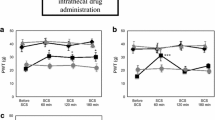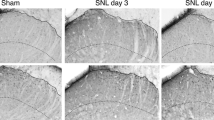Abstract
Aim Spinal cord transection interrupts supraspinal input and leads to the development of prominent spasticity. In this study, we investigated the effect of rat spinal cord transection performed at low thoracic level on changes in (i) neuronal nitric oxide synthase immunoreactivity (nNOS-IR), and (ii) the level of neuronal nitric oxide synthase (nNOS) protein in the neuronal circuitry that underlies tail-flick reflex. Methods nNOS-IR was detected by immunohistochemistry and the level of nNOS protein was determined by the Western blot analysis. The tail-flick reflex was tested by a noxious thermal stimulus delivered to the tail of experimental animals. After surgery, experimental animals survived for 7 days. Results A significant increase in the level of nNOS protein was found 1 week after thoracic transection in the L2–L6 segments. Immunohistochemical analysis discovered that this increase may be a result of (1) a high nNOS-IR in a large number of axons, located predominantly in the dorsal columns (DCs) of lower lumbosacral segments, and (2) a slight increase of density in nNOS-IR in motoneurons. On the other hand the number of nNOS-IR neurons in the superficial dorsal horn and in area surrounded the central canal (CC) was greatly reduced. The tail-flick response was immediate in animals after spinal transection, while control rats responded to thermal stimulus with a slight delay. However, the tail-flick latency in experimental animals was significantly higher than in control. Conclusion These data indicate that transection of the spinal cord significantly influences nNOS-IR in neuronal circuitry that underlies the tail-flick reflex activity.





Similar content being viewed by others
References
Anelli R, Heckman CJ (2005) The calcium binding proteins calbindin, parvalbumin, and calretinin have specific patterns of expression in the gray matter of cat spinal cord. J Neurocytol 34:369–385
Bentrand S, Cazalets JR (1999) Presynaptic GABAergic control of the locomotor drive in the isolated spinal cord of neonatal rats. Eur J NeuroSci 11:583–592
Bradford MM (1976) A rapid and sensitive method for the quantitation of microgram quantities of protein utilizing the principle of protein-dye binding. Anal Biochem 72:248–254
Brown LT (1971) Projections and termination of the corticospinal tract in rodents. Exp Brain Res 13:432–450
Brown LT (1974) Rubrospinal projections in the rat. J Comp Neurol 154:169–188
Ciriello J, Calaresu FR (1983) Central projections of afferent renal fibers in the rat: an anterograde transport study of horseradish peroxidase. J Auton Nerv Syst 8:273–285
Čížková D, Lukáčová N, Maršala M, Maršala J (2002) Neuropathic pain is associated with alterations of nitric oxide synthase immunoreactivity and catalytic activity in dorsal root ganglia and spinal dorsal horn. Brain Res Bull 58:161–171
de Louw AJ, de Vente J, Steinbusch HP, Steinbusch HW, Troost J, Vles JS (2002) Baclofen inhibits ANP-mediated cyclic GMP synthesis in the rat cervical spinal cord. Neurosci Lett 321:120–122
Dun NJ, Dun SL, Wu SY, Förstermann U, Schmidt HH, Tseng LF (1993) Nitric oxide synthase immunoreactivity in the rat, mouse, cat and squirrel monkey spinal cord. Neuroscience 54:845–857
Gebhart E (1987) Clastogenic action of chemotherapy in humans (review). In Vivo 1:15–21
Hefferan MP, Fuchigami T, Marsala M (2006) Development of baclofen tolerance in a rat model of chronic spasticity and rigidity. Neurosci Lett 403:195–200
Ito S, Okuda-Ashitaka E, Minami T (2001) Central and peripheral roles of prostaglandins in pain and their interactions with novel neuropeptides nociceptin and nocistatin. Neurosci Res 41:299–322
Jasmin L, Carstens E, Basbaum AI (1997) Interneurons presynaptic to rat tail-flick motoneurons as mapped by transneuronal transport of pseudorabies virus: few have long ascending collaterals. Neuroscience 76:859–876
Jessell TM, Iversen LL, Cuello AC (1978) Capsaicin-induced depletion of substance P from primary sensory neurones. Brain Res 152:183–188
Juszkiewicz-Donsbach J, Levy G (1962) Effect of small variations in heat stimulus temperature on the tail flick response of rats in analgesimetry. J Pharm Sci 51:185–186
Kakinohana O, Hefferan MP, Nakamura S, Kakinohana M, Galik J, Tomori Z, Marsala J, Yaksh TL, Marsala M (2006) Development of GABA-sensitive spasticity and rigidity in rats after transient spinal cord ischemia: a qualitative and quantitative electrophysiological and histopathological study. Neuroscience 141:1569–1583
Kawai K, Penix LP, Tuetzler CA, Nitecha L, Lohr JM, Klatzo I (1992) Effect of cardiac arrest cerebral ischemia on the GABAergic system and development of audiogenic seizures. In: Krieglstein J, Oberpichler-Schwenk H (eds) Pharmacology of cerebral ischemia. Wissenschaftliche, Stuttgart, pp 195–206
Kluchova D, Pribula J, Rybarova S, Schmidtova K, Miklosova M, Lovasova K, Dorko F (2000) Variation in the localization of NADPH-d positive neurons in the gray matter of the spinal cord in different species. Bratisl Lek Listy 101:558–564
Lance JW (1980) Spasticity: disordered motor control. In: Feldman RG, Yound RR, Koella WP (eds) Symposium synopsis. Year Book Medical, Chicago, pp 485–494
Lazorthes Y, Sallerin-Caute B, Verdie JC, Bastide R, Carillo JP (1990) Chronic intrathecal baclofen administration for control of severe spasticity. J Neurosurg 72:393–402
Lukáčová N, Čížková D, Maršala M, Jalc P, Maršala J (1999) Segmental and laminar distributions of nicotinamide adenine dinucleotide phosphate-diaphorase-expressing and neuronal nitric oxide synthase-immunoreactive neurons versus radioassay detection of catalytic nitric oxide synthase activity in the rabbit spinal cord. Neuroscience 94:229–237
Lukáčová N, Čížková D, Maršala M, Lukáč I, Maršala J (2002) The regional distribution of nitric oxide synthase activity in the spinal cord of the dog. Brain Res Bull 58:173–178
Lukáčová N, Čížková D, Križanová O, Pavel J, Maršala M, Maršala J (2003) Peripheral axotomy affects nicotinamide adenine dinucleotide phosphate diaphorase and nitric oxide synthases in the spinal cord of the rabbit. J Neurosci Res 71:300–313
Lukáčová N, Pavel J, Kuchárová K, Maršala J (2005) Plasticity of the spinal neural circuitry in nitric oxide synthase immunoreactive pathways after spinal cord hemisection. In: Coleman RM (ed) Trends in neurochemistry research. Nova Science Publisher, Inc., New York, pp 189–222
Lukáčová N, Kolesárová M, Kuchárová K, Pavel J, Kolesár D, Radoňák J, Maršala M, Chalimoniuk M, Langfort J, Maršala J (2006) The effect of a spinal cord hemisection on changes in nitric oxide synthase pools in the site of injury and in regions located far away from the injured site. Cell Mol Neurobiol 26:1367–1385
Lukáčová N, Dávidová A, Kolesár D, Kolesárová M, Schreiberová A, Lacková M, Križanová O, Maršala M, Maršala J (2008) The effect of N-nitro-L-arginine and aminoguanidine treatment on changes in constitutive and inducible nitric oxide synthases in the spinal cord after sciatic nerve transection. Int J Mol Med 21:413–421
Malcangio M, Bowery NG (1996) GABA and its receptors in the spinal cord. Trends Pharmacol Sci 17:457–462
Maršala J, Šulla I, Santa M, Maršala M, Mechírová E, Jalč P (1989) Early neurohistopathological changes of canine lumbosacral spinal cord segments in ischemia-reperfusion-induced paraplegia. Neurosci Lett 106:83–88
Maršala J, Vanický I, Maršala M, Jalc P, Orendáčová J, Taira Y (1998) Reduced nicotinamide adenine dinucleotide phosphate diaphorase in the spinal cord of dogs. Neuroscience 85:847–862
Maršala J, Maršala M, Vanický I, Taira Y (1999) Localization of NADPHd-exhibiting neurons in the spinal cord of the rabbit. J Comp Neurol 406:263–284
Maršala J, Lukáčová N, Čižková D, Kafka J, Katsube N, Kuchárová K, Maršala M (2002) The case for the bulbospinal respiratory nitric oxide synthase-immunoreactive pathway in the dog. Exp Neurol 177:115–132
Maršala J, Lukáčová N, Čižková D, Lukáč I, Kuchárová K, Maršala M (2004) Premotor nitric oxide synthase immunoreactive pathway connecting lumbar segments with the ventral motor nucleus of the cervical enlargement in the dog. J Chem Neuroanat 27:43–54
Maršala M, Hefferan MP, Kakinohana O, Nakamura S, Maršala J, Tomori Z (2005a) Measurement of peripheral muscle resistance in rats with chronic ischemia-induced paraplegia or morphine-induced rigidity using a semi-automated computer-controlled muscle resistance meter. J Neurotrauma 22:1348–1361
Maršala J, Lukáčová N, Sulla I, Wohlfahrt P, Maršala M (2005b) The evidence for nitric oxide synthase immunopositivity in the monosynaptic Ia-motoneuron pathway of the dog. Exp Neurol 195:161–178
Maršala J, Lukáčová N, Kolesár D, Kuchárová K, Maršala M (2006) Nitrergic proprioceptive afferents originating from quadriceps femoris muscle are related to monosynaptic Ia-motoneuron stretch reflex circuit in the dog. Cell Mol Neurobiol 26:1387–1412
Maršala J, Lukáčová N, Kolesár D, Sulla I, Gálik J, Maršala M (2007) The distribution of primary nitric oxide synthase- and parvalbumin-immunoreactive afferents in the dorsal funiculus of the lumbosacral spinal cord in a dog. Cell Mol Neurobiol 27:475–504
Maxwell DJ, Belle MD, Cheunsuang O, Stewart A, Morris R (2007) Morphology of inhibitory and excitatory interneurons in superficial laminae of the rat dorsal horn. J Physiol 584:521–533
Mayer NH (1997) Clinicophysiologic concepts of spasticity and motor dysfunction in adults with an upper motoneuron lesion. Muscle Nerve 6(Suppl):S1–S13
McBrude R, Feringa ER (1991) Ventral horn motoneurons 10, 20 and 52 weeks after T-9 spinal cord transection. Brain Res Bull 28:57–60
Meller ST, Gebhart GF (1993) Nitric oxide (NO) and nociceptive processing in the spinal cord. Pain 52:127–136
Nahin RL, Madsen AM, Giesler GJ Jr (1983) Anatomical and physiological studies of the gray matter surrounding the spinal cord central canal. J Comp Neurol 220:321–335
Onifer SM, Rabchevsky AG, Scheff SW (2007) Rat models of traumatic spinal cord injury to assess motor recovery. ILAR J. 48:385–395
Orendáčová J, Maršala M, Šulla I, Kafka J, Jalc P, Čižková D, Taira Y, Maršala J (2000) Incipient cauda equina syndrome as a model of somatovisceral pain in dogs: spinal cord structures involved as revealed by the expression of c-fos and NADPH diaphorase activity. Neuroscience 95:543–557
Ren K, Ruda MA (1994) A comparative study of the calcium-binding proteins calbindin-D28 K, calretinin, calmodulin and parvalbumin in the rat spinal cord. Brain Res Brain Res Rev 19:163–179
Saito K (1974) The synaptology and cytology of the Clarke cell in nucleus dorsalis of the cat: an electron microscopic study. J Neurocytol 3:179–197
Sasek CA, Seybold VS, Elde RP (1984) The immunohistochemical localization of nine peptides in the sacral parasympathetic nucleus and the dorsal gray commissure in rat spinal cord. Neuroscience 12:855–873
Seebach BS, Mendell LM (1996) Maturation in properties of motoneurons and their segmental input in the neonatal rat. J Neurophysiol 76:3875–3885
Tessler A, Himes BT, Artymyshyn R, Murray M, Goldberger ME (1981) Spinal neurons mediate return of substance P following differentiation of cat spinal cord. Brain Res 230:263–281
Thompson FJ, Parmer R, Reier PJ, Wang DC, Bose P (2001) Scientific basis of spasticity: insights from a laboratory model. J Child Neurol 16:2–9
Valtschanoff JG, Weinberg RJ, Rustioni A (1992) NADPH diaphorase in the spinal cord of rats. J Comp Neurol 321:209–222
Verheul HB, de Leeuw FE, Scholten G, Tulleken CAF, Lopes da Silva FH, Ghijsen WEJM (1993) GABAA receptor function in the early period after transient forebrain ischemia in the rat. Eur J NeuroSci 5:955–960
Wheal HV, Chen Y, Mitchell J, Schachner M, Maerz W, Wieland H, Van Rossum D, Kirsch J (1998) Molecular mechanisms that underlie structural and functional changes at the postsynaptic membrane during synaptic plasticity. Prog Neurobiol 55:611–640
Woolacott AJ, Burne JA (2006) The tonic stretch reflex and spastic hypertonia after spinal cord injury. Exp Brain Res 174:386–396
Wu W (1993) Expression of nitric-oxide synthase (NOS) in injured CNS neurons as shown by NADPH diaphorase histochemistry. Exp Neurol 120:153–159
Acknowledgments
The authors thank Mrs. A. Košová and Mrs. M. Syneková for their excellent technical assistance. The experimental work was supported by the APVV grant 0314-06, VEGA Grant 2/0015/08 from the SAS, and by CEKVY 2007/2010.
Author information
Authors and Affiliations
Corresponding author
Rights and permissions
About this article
Cite this article
Dávidová, A., Schreiberová, A., Kolesár, D. et al. Spinal Cord Transection Significantly Influences nNOS-IR in Neuronal Circuitry that Underlies the Tail-Flick Reflex Activity. Cell Mol Neurobiol 29, 879–886 (2009). https://doi.org/10.1007/s10571-009-9370-x
Received:
Accepted:
Published:
Issue Date:
DOI: https://doi.org/10.1007/s10571-009-9370-x




